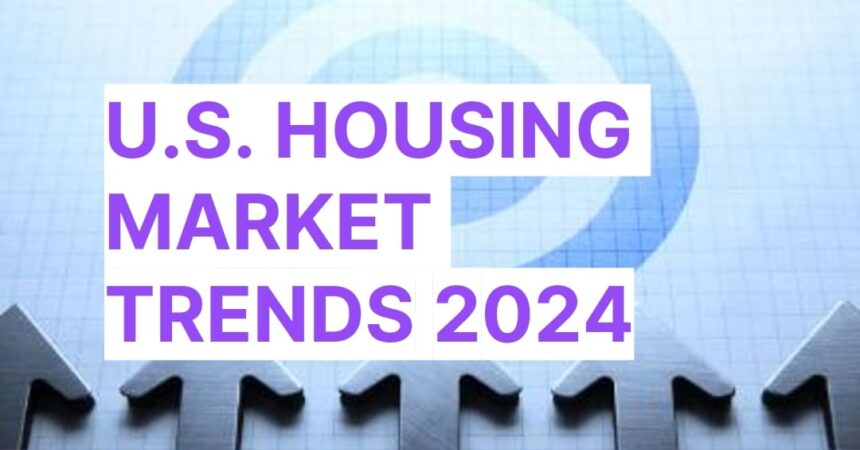Housing Market Trends: April 2024
The housing market in April 2024 presented a complex picture with both positive and negative signs for potential buyers and sellers. Existing home sales unexpectedly fell in April as higher mortgage rates and house prices weighed on demand, dealing another setback to the housing market.
Though the report from the National Association of Realtors on Wednesday showed inventory increasing last month to a 2-1/2-year high entry-level homes remained scarce, accounting for the second straight monthly decline in sales. Here’s a breakdown of the key trends:
Existing-Home Sales
In April, total existing-home sales, encompassing various property types such as single-family homes, townhouses, condominiums, and co-ops, declined by 1.9% from the previous month, amounting to a seasonally adjusted annual rate of 4.14 million transactions. Year-over-year, sales also fell by 1.9%.
NAR’s Chief Economist, Lawrence Yun, noted that while overall home sales remained relatively stable, the upper-end market experienced significant growth, attributed to an increase in housing supply.
Housing Inventory and Prices
The total housing inventory at the end of April stood at 1.21 million units, marking a 9% increase from March and a 16.3% increase from the previous year. Unsold inventory represented a 3.5-month supply at the current sales pace, indicating a slight uptick from the previous month and year. Particularly noteworthy was the surge in inventory and sales for homes priced at $1 million or more, which saw increases of 34% and 40%, respectively, compared to the previous year.
The median existing-home price for all housing types in April reached $407,600, reflecting a 5.7% increase from the previous year. While this surge in prices is favorable for homeowners, Yun emphasized the importance of a gradual tapering off in price increases as housing inventory continues to expand.
REALTORS® Confidence Index
The REALTORS® Confidence Index revealed that properties typically spent 26 days on the market in April, a decrease from the previous month but an increase compared to the same period last year. First-time buyers accounted for 33% of sales in April, with all-cash sales maintaining a steady share of 28% of transactions. Individual investors or second-home buyers represented 16% of home purchases in April.
Mortgage Rates
According to Freddie Mac, the 30-year fixed-rate mortgage averaged 7.02% as of May 16, showing a slight decrease from the previous week but a notable increase compared to the previous year.
Regional Variations
Regional disparities were observed in existing-home sales and pricing:
- Northeast: Existing-home sales declined by 4% from March, with a median price increase of 8.5% compared to the previous year.
- Midwest: Sales slipped by 1% from the previous month, accompanied by a 6% median price increase from April 2023.
- South: Sales descended by 1.6% from March, with a 3.7% median price increase compared to the previous year.
- West: Sales retracted by 2.6% from the previous month but saw a 9.3% median price increase compared to April 2023.
The April housing data suggests a potential shift in the market. Rising inventory and a slowdown in sales point towards a more balanced market compared to the recent seller’s advantage. However, high home prices and mortgage rates might continue to pose challenges for some buyers. It will be interesting to see how these trends play out in the coming months.
Future Housing Market Trends
Buyers may have more leverage in negotiations in 2024, but the market is still competitive in many areas. The housing market has been cooling down since last year, but it’s still too early to say whether it will be a buyers or sellers market. Some areas are becoming more buyer-friendly and others remain seller-friendly.
Here are some factors that are contributing to this shift in the housing market to become more buyer-friendly:
- Rising interest rates: Mortgage rates have been rising since last year, making it more expensive for buyers to finance a home. If it continues this year, this is expected to slow down demand and give buyers more leverage in negotiations.
- Rising inflation: Inflation is also on the rise, which is making it more expensive for everyone to live, including homeowners. This could lead to some sellers being more willing to sell their homes at a lower price.
- Increasing inventory: The supply of homes for sale is slowly starting to increase, which is also giving buyers more options.
The cooling of the housing market could be terrible news for sellers, but for buyers, it’s great. Yet there is still the problem of sky-high mortgage rates. The bright side is that if buyers hold off, the supply of homes will increase, putting further pressure on sellers to decrease prices. This would constitute a long-overdue course correction for the housing market. Mortgage rates are skyrocketing. Home sales are declining. Supply is improving. We are witnessing a sharp slowdown in the housing market due to higher mortgage rates.
Housing Market Trend #1: Increasing Demand for Affordable Housing
The demand for affordable housing is one of the most pressing issues in the housing market. The rise in housing prices, combined with stagnant wages, has made it difficult for many individuals and families to find safe and secure housing. In 2023, it is expected that access to affordable housing will continue to be a challenge. Innovative solutions will be necessary to address this issue and provide affordable housing options for those in need.
Housing Market Trend #2: Shift toward Suburban and Rural Areas
The COVID-19 pandemic has caused many people to reevaluate their living arrangements, with larger homes and more space becoming increasingly important. This shift in priorities could result in a greater demand for housing in suburban and rural areas, leading to higher prices. This trend is expected to continue in 2023, especially as remote work becomes more prevalent.
Housing Market Trend #3: Rising Home Prices
Despite the economic impact of the pandemic, housing prices have continued to rise due to limited supply and high demand. While this is good news for homeowners, it could make it more difficult for some individuals to enter the housing market. The trend toward rising home prices is expected to persist in 2023, particularly in urban areas where the supply is limited.
Housing Market Trend #4: Stricter Mortgage Standards
As the economy recovers and interest rates rise, mortgage lenders may become more cautious about who they lend to. This could make it more difficult for some individuals to qualify for a mortgage and realize their dream of homeownership. Stricter mortgage standards are a potential barrier for those seeking to enter the housing market.
Trend #5: Increased Investment in Technology
The pandemic has accelerated the adoption of technology in the real estate industry, with virtual home tours and digital transactions becoming more common. This trend is expected to continue in 2023, with technological investments helping to streamline the home buying and selling process. Technology could also play a role in addressing the challenge of affordable housing, with innovations such as modular homes and 3D printing.
Hence, the housing market in 2023 will be shaped by economic, social, and technological factors. While predicting the future is never easy, understanding these trends can help individuals and policymakers make informed decisions about the housing market. It is important to address the challenge of affordable housing, as well as the potential barriers to homeownership such as rising home prices and stricter mortgage standards. Technological innovations are also likely to play a critical role in shaping the housing market in the coming years. By keeping these trends in mind, stakeholders can work towards creating a housing market that is equitable, accessible, and sustainable for all.
Benefits for Homebuyers in 2024’s Housing Market
There are a few potential benefits for homebuyers in the current real estate housing market:
- More choices: While the supply of homes on the market is still relatively low, it has increased slightly in recent months. This means that potential homebuyers may have more options to choose from when looking for a home. The number of new homes available on the market also increased in February, which means that potential homebuyers have more options to choose from.
- Slower price growth: Although home prices are still rising, the pace of growth has slowed down in some areas. This could make it easier for homebuyers to afford a home in certain markets.
- Easier negotiations: In a slower housing market, sellers may be more willing to negotiate on the price of their home or other terms of the sale. This could give homebuyers more bargaining power and help them get a better deal on a home.
- Lower prices: While the median price of a new home rose slightly from a year ago, the increased inventory could lead to greater competition among sellers, potentially driving down prices.
- Leading indicator: New home sales are considered a leading indicator for the housing market, meaning that an increase in new home sales could signal a positive trend for the housing market overall. This could be good news for potential homebuyers who may be hesitant to enter the market during a downturn.
Looking ahead to 2024, the US housing market, key trends and factors will shape the real estate landscape. These include the influence of interest and mortgage rates on buyer demand, the persistent challenge of limited housing inventory, steady growth in home prices, and concerns over affordability for potential buyers.
Generational shifts and the impact of remote work will also shape housing preferences, while government policies and regional variations will contribute to market dynamics. Overall, staying informed and adaptable will be crucial for navigating the evolving housing landscape in the coming months.
One key factor to watch is the potential impact of policy considerations, such as a temporary reduction in capital gains tax on investment property sales. If implemented, this measure could stimulate the market by increasing housing inventory, sales, and overall economic growth. Policymakers will need to carefully evaluate and balance the potential benefits of such measures against any unintended consequences.
Addressing the challenges of housing inventory and supply levels will be critical moving forward. Collaborative efforts among policymakers, industry professionals, and stakeholders will be necessary to find sustainable solutions. Encouraging an increase in housing inventory will help meet the demand from prospective buyers and potentially stabilize prices.
Localized data and insights will continue to be essential for making informed decisions. Consulting with local associations of REALTORS® and utilizing data from local multiple listing services (MLS) can provide accurate and detailed information specific to particular areas. This will help individuals and businesses navigate market conditions effectively and make strategic choices.
Monitoring forthcoming releases of key indicators, such as the Pending Home Sales Index and Existing-Home Sales data, will offer valuable insights into the evolving trends and dynamics of the real estate market. Staying informed and adaptable to changing conditions will be crucial for making well-informed decisions and seizing opportunities in this dynamic landscape.
While challenges persist, the real estate market also presents opportunities for growth and investment. With careful analysis of market conditions, consideration of policy measures, and collaboration among industry stakeholders, the real estate sector can strive toward a more balanced and sustainable future in 2024.











